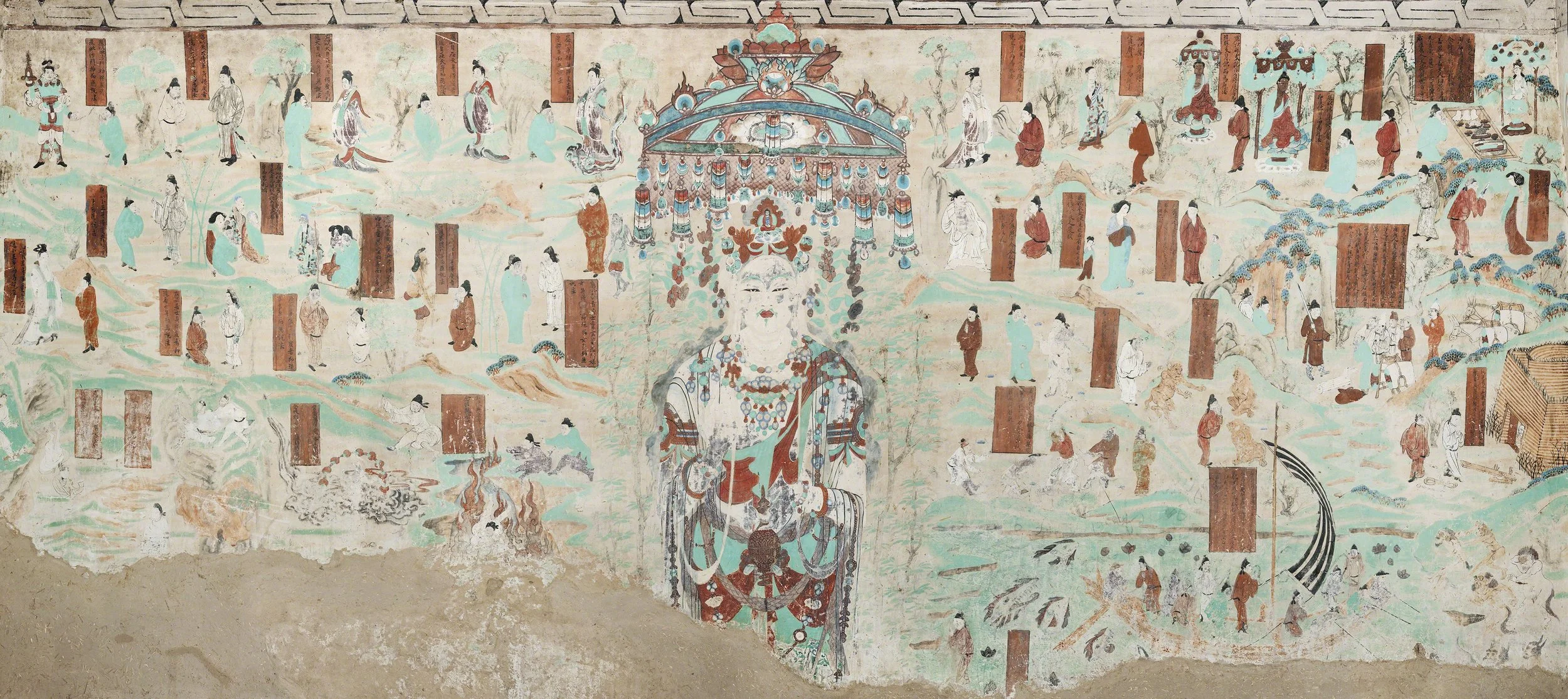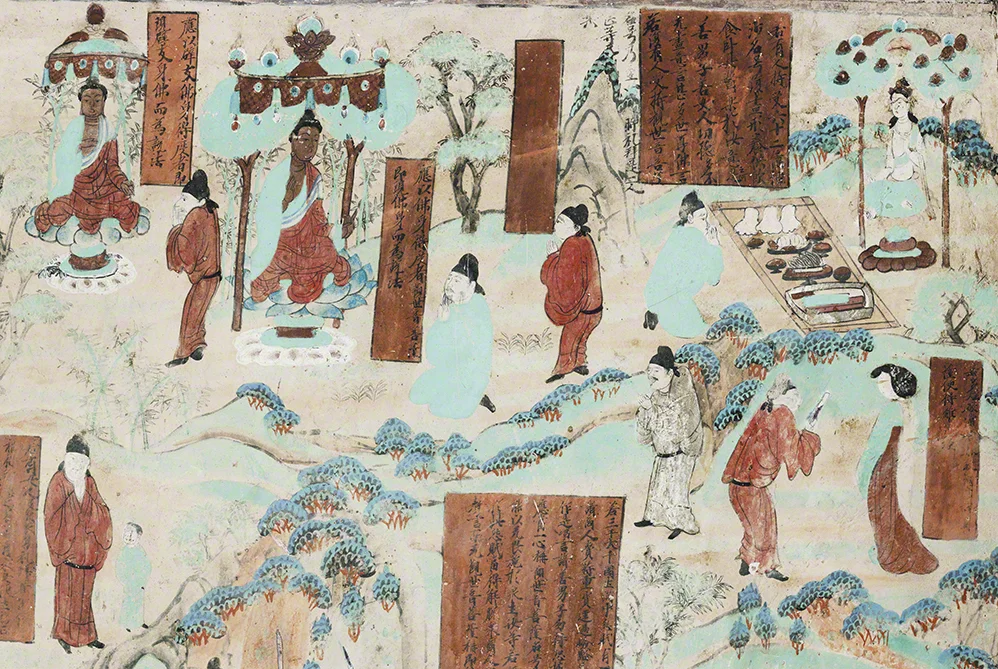Guanyin of the Universal Gateway in Mogao Cave 45. 705-781 CE. Late Tang Dynasty. Dunhuang. Image Courtesy of the Dunhuang Academy.
“There is no place where he will not manifest himself.
The suffering of those in the troubled states of being:
Hell-dwellers, hungry ghosts, and animals;
And the suffering of birth, old age, illness, and death
Will gradually be extinguished.”
It is generally agreed among Chinese Buddhists and scholars of Buddhist studies that the figure Guanyin is the Bodhisattva Avalokitesvara.
As a reminder from last week, Avalokitesvara is the bodhisattva who represents compassion. The Lotus Sutra, one of the most important texts in Mahayana Buddhism, describes Avalokitesvara extensively in Chapter 25. Avalokitesvara is also an interlocutor in the Heart Sutra, the short but influential sutra on the perfection of wisdom.
Guanyin in Chinese means "Perceiver of all Sounds," which refers to the way in which Guanyin is able to hear all prayers and cries for help.
Bodhisattva Avalokitesvara in Water Moon Form (Shuiyue Guanyin). 11th century. Liao Dynasty. China. Image Courtesy of The Met.
In India, bodhisattvas are genderless or are referred to as male. The Bodhisattva Avalokitesvara, or Guanyin, is often depicted as female in China.
One reason for this gender fluidity is due to the way the Bodhisattva has the ability to manifest on earth in many different forms.
One of Avalokitesvara's many forms is Padmapani Lokesvara, which means "Lord with a Lotus in his Hand."
The Bodhisattva Padmapani Lokesvara. 11th century. Kathmandu Valley, Nepal. Image Courtesy of The Met.
Below is a detail from the Guanyin mural in Mogao Cave 45 at Dunhuang.
The larger image (found at the beginning of this post) depicts Chapter 25 of the Lotus Sutra, which describes the way in which Avalokitesvara appears to all who need help, in whatever form.
The detail below represents several different scenes in which a human being is in a supplicatory posture facing another figure. That other figure is Avalokitesvara manifesting on earth as either male or female, deity or human.
Detail of the some of the forms Guanyin takes when s/he manifests on Earth, from the Guanyin of the Universal Gateway Mural in Mogao Cave 45. 705-781 CE. Late Tang Dynasty. Dunhuang. Image Courtesy of the Dunhuang Academy.
Another reason for the tendency towards a feminine representation of Avalokitesvara in China has to do with the fact that the Chinese often prayed to Guanyin for children, especially sons.
This sometimes worked, and statues of Guanyin in certain temples would become known for their ability to bestow sons.
The ivory statue below represents Guanyin as the "Bestower of Sons."
Buddhist deity Guanyin (Bodhisattva Avalokitesvara). 16th century. Ming dynasty. China. Image courtesy of The Met.
Below is another depiction of Guanyin bestowing a son.
Besides Guanyin, another important figure featured in this lavish Ming painting is Sudhana, the young boy at the feet of the majestic lion.
Guanyin Bestowing a Son. Late 16th century. Ming Dynasty. China. Image Courtesy of The Met.
In the Gandavyuha Sutra, Sudhana is the protagonist who journeys to Mount Potalaka seek advice on enlightenment from Avalokitesvara.
The sutra describes the mythical home of Avalokitesvara as an isolated mountain rising out of the seas.
“The precise location of the mountain is the subject of considerable speculation. According to Xuanzhang, it is located in southern India to the east of the Malaya Mountains. He describes it as a perilous mountain with a lake and a heavenly stone palace at the summit. A river flows from the summit, encircling the mountain twenty times before flowing into the South Sea. Those who seek to meet the bodhisattva scale the mountain, but few succeed.”
~ The Princeton Dictionary of Buddhism. Edited by Donald S. Lopez Jr. and Robert E. Buswell Jr.
The Chinese interpretation of Potalaka is Mount Putuo, which Chinese Buddhists believe to be in Zhejiang Province.
White-Robed Guanyin. Late 14th century. Ming dynasty. China. Image courtesy of The Met.
Another popular form of Guanyin is the White-Robed Guanyin, the form in which Avalokitesvara wears a clean, white robe in the tranquil, otherworldly setting of Mount Putuo.
The artist of this painting is unknown, but the poem at the top was stamped by Ming official Quan Shi Zong Le. From right to left, the poem reads:
“Like a speck of dust, ephemeral is the body,
So is the doctrine ephemeral, like a speck of dust.
Only when all sentient beings and the world attain emptiness
Will [Guanyin]’s all-compassionate heart rest.”
Further Reading
- Buddha Weekly: Guan Yin and the ten great protections of the Goddess of Mercy
- Indira Gandhi National Centre for the Arts: The Creation of the Goddess of Mercy from Avalokitesvara
- The Met: White Robed Guanyin
- Oxford Research Encyclopedias: Avalokitesvara, the Bodhisattva of Compassion
- Plum Village: The Heart Sutra translated by Thich Nhat Hanh
The Lotus Sutra. Translated by Tsugunari Kubo and Akira Yuyama. Berkeley: Bukkyō Dendō Kyōka Numata (2007).
Buswell, Robert E., Donald S. Lopez. The Princeton Dictionary of Buddhism. Princeton: Princeton University (2004).
Fong, Wen. Beyond Representation: Chinese Paintings and Calligraphy, 8th-14th Century. New York: The Metropolitan Museum of Art (1992).







